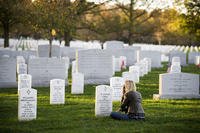I became really excited for my children when I readan article title. I do truly know better than to let a title get me excited before Iunderstandthe program details, but I got excited anyway.I did the same thing back in the day whenmy MyCAA first came out.
Anyway, the article titled Virtual High School Opens 'Doors' to Learningcaught my attention. I read it and I jumped onto the FAQswebsite.This program isnot available for all militarychildren, there arerestrictions on who canutilize the program. That disappointed me becauseall military children truly need education flexibility.
It sounds as if itwill be a wonderful program for those that are able to take advantage of it, butlimiting use(for example, to those who want and/or are able to get on installation housing) leaves out a huge number of military children that could truly benefit from a program such as this. I understand that DoDEA schools on installation can only accommodate a certain number of children, but I had hoped that the 'virtual school' would be available for all military children that are in need ofsupplemental programs.
The Defense Department's newest high school is devoid of walls or windows, but yet has opened its "doors" this year to students scattered around the globe.
The Department of Defense Education Activity's virtual high school is an accredited distance-learning program for military students, whether they're geographically separated, transitioning between schools or just dealing with a scheduling conflict.
"It's a wonderful opportunity to close gaps and enhance students' educational experience in a 21st century environment," Marilee Fitzgerald, the activity's acting director, said. "I think it opens up possibilities for learning that we have yet to understand, yet to explore."
The virtual school offers students 48 online courses in a wide range of disciplinary areas, including foreign language, math, science, social studies, language arts and physical education, as well as 15 advanced placement courses. The school also is equipped to offer English as a second language and special education, Patricia Riley, chief of the activity's distance learning and virtual school, said.
The school primarily is designed for students eligible to attend a Defense Department school but are living in remote locations, Riley said, noting that students from as far away as Australia and Papua New Guinea already have enrolled. Most attend local schools but need courses such as U.S. history to graduate, she explained, and the virtual high school can help to fill this gap.
Next up on the priority list are students currently attending Defense Department schools, Riley said. Students are asked to seek traditional in-school classes first, but can request online access when there's a scheduling conflict or if a required course isn't offered in the school. The virtual school also is useful, for instance, for students transitioning from overseas to stateside, or from a Defense Department to public school, who need to ensure they meet the requirements for their new school, she added.
"This school is particularly important for military dependent students, who do move more often," Riley said, noting she's talked to parents whose children have attended up to four different schools during their high school careers.
"The flexibility of scheduling is critical and speaks to the transition needs of students in military families," Riley said. Education activity officials are "well aware of the curriculum needs and planning that needs to take place to help students meet academic goals."
The courses are self-paced, but students still receive support every step of the way. Teachers are located in three hubs -- Wiesbaden, Germany; Camp Humphries, South Korea; and Arlington, Va. - and offer real-time online support to students scattered worldwide in a range of time zones, Riley said.
"We strategically placed them in different parts of the world to be closer to where students are," she explained.
This live support enables Web conferencing, peer-to-peer data sharing and question-and-answer sessions with teachers. "They're also there to simulate the true classroom experience of a face-to-face environment," Riley said.
The school has a model of 20 to 25 teachers per 1,000 students, but is far from full capacity, Riley said. Additionally, the school has a "virtual counselor" who works in concert with counselors at local schools. The counselor can help students identify possible voids and fill those requirements with virtual classes, she added.
As for the road ahead, Riley said plans are in the works to make the virtual school diploma-granting, which would require the school to offer all of the courses needed to meet graduation requirements. The virtual high school currently operates as a supplemental school, she explained, meaning it's intended to fill in the gaps rather than replace the activity's brick-and-mortar schools.
"The majority of students only need supplemental courses," Riley said. "However, we also want to accommodate those students who are in isolated situations and might need the ability to acquire a diploma from a distance."
Officials also hope to create virtual elementary and middle schools down the road, Riley said. "But this high school is a great starting point and increases education opportunities for our students."
Fitzgerald called the virtual high school a "great step forward."
"It's an important contribution to the way we educate children in the 21st century DoDEA," she said.
What are your thoughts on this program?
Links:
Information from the DoDEA website:
DoDEA has a proud, 60+ year history of providing quality education for children of military families, the majority of which has been taught in traditional "brick and mortar" classrooms. As an organization dedicated to continually improving the education experience for our students, DoDEA is currently developing additional academic opportunities through the use of 21st Century learning and communication tools.
"We are in the process of developing a fully- accredited Virtual High School," said Patricia Riley, Chief of DoDEA Distance Learning/Virtual School. "This doesn't mean we would expect students to attend the Virtual School from 9th through 12th grade, necessarily, but the Virtual High School will increase education options for DoDEA- eligible students."
Although DoDEA has offered distance- learning courses since the early 1980s, the Virtual School will eventually offer a complete curriculum of courses necessary for a student to graduate from high school.
"This is our transition year," said Riley. "The true launch of the Virtual High School will occur in the 2010- 2011 school year. Right now we're focusing on transitioning our distance learning program into a fully accredited comprehensive virtual high school."
Overseas, the Virtual High School will use the same criteria for eligibility as DoDEA schools. Eligibility for enrollment in DoDEA's overseas school system is determined through categories (see sidebar). Eligibility for attendance in DoDEA schools in the continental U.S. remains the same - the sponsor must be assigned permanent quarters on the installation and an active duty or federal civilian employee. According to Riley, the criteria for students located in the U.S. territories is still being clarified.
The Virtual High School will assist transitioning DoDEA students by allowing them to take classes they need regardless of their location and enhance curriculum by providing additional resources to fill gaps, assist in transition and provide flexibility in scheduling.
Riley explained that the Virtual High School is not going to replace or compete with face- to- face instruction. "If a course is offered at a local DoDEA school, a student will be required to attend that course unless there is a schedule conflict. They wouldn't have the option of taking the class virtually if they can get the same course in a traditional classroom," Riley added.
There will be 33 new courses available by the official start of the program in the fall of 2010. In addition, the Virtual High School will continue to provide courses to supplement DoDEA school offerings such as Advanced Placement courses.
"Another important distinction is that DoDEA will own the content of these courses," Riley said. "Which means the content will be the same whether you're in a DoDEA traditional classroom or you're taking the class on- line."
"So if a student was taking a course in a DoDEA school and had to leave mid - semester and move to another DoDEA school where the course wasn't offered, the student could pick up where he or she left off through the virtual class."
There will be three hubs for the Virtual High School to accommodate the three different areas of the world that the school will serve. The first hub has already been established in Wiesbaden, Germany. The second will be in Korea at Camp Humphries. The third hub will be at an as yet undetermined location within the continental U.S.
"These locations - within the different time zones - will allow for synchronous learning," said Riley.
While some learning will be able to take place any time the student chooses (reading, research, etc.) some of the requirements will be to participate in live, on- line discussions and video or audio chats. Although the use of synchronous support is not new to DoDEA's distance learning program, new and improved web- conferencing tools will enhance online instruction and provide students and teachers with opportunities to interact via the Internet.
"We're preparing our students for life in the 21st century," said Riley. "So offering them opportunities to learn in ways that utilize technology just makes sense. It's an exciting time for DoDEA whether you're an educator, a parent or a student."









